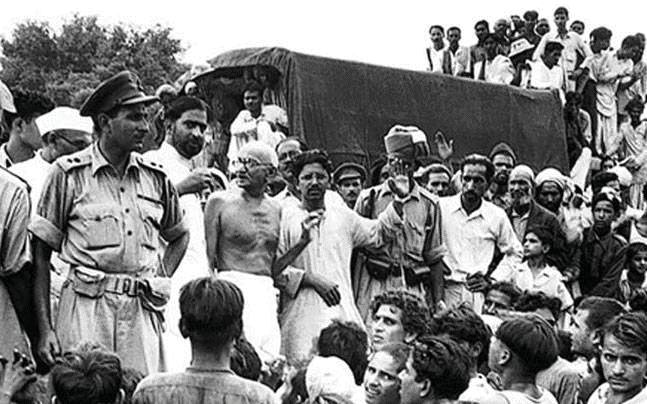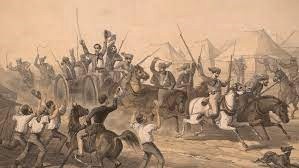 A file picture of the Champaran
A file picture of the Champaran
Satyaraha led by Mohandas K Gandhi
The central Indian states of Madhya Pradesh, Uttar Pradesh, Bihar and Odisha have also played a very important role in India’s freedom struggle. Some of these regions were actively participating in the independence movement and the revolts against the British rule.
It was the Portuguese who were the first European to enter Bihar for trade of spices, etc. Later, in 1579, Mughal king Akbar allowed the Portuguese to establish a factory at Hooghly and about 20 years later the Portuguese built a convent and a church in Bandel.
Arrival of the British
The British, through the East India Company, built a factory at Alamganj in Patna in 1620 but it got closed a year later. After three decades, the British revived the factory and it is now a printing press at Gulzar Bagh. The Dutch East India Company too established a factory in Patna in 1632 followed by the Danes East India Company that established their factory at Nepali Kothi in Patna in 1774.
The Battle of Buxar of 1764 was fought between the British and the Mughals and the Nawabs of Bengal and Awadh. It led to the two treaties of Allahabad for the Diwani rights of Bengal and Bihar. These were the early signs of oppression by the British.
The revolt of 1857 had reached Bihar also where it started on 12 June 1857 in the Deoghar district which is now in Jharkhand at the headquarters of the 32nd Infantry Regiment. Two British officers Lt. Norman Leslie and Sergeant Dr. Grant were involved in this revolt that was soon crushed.
A few days later, on 3 July, the uprising reached Patna under Peer Ali and other rebels. They first attacked a Roman Catholic priest’s house who had escaped and later killed Dr Lyell who was the principal assistant to an opium agent. Many rebels were shot and killed by the British.
The first resistance
The first widespread uprising in this region was the revolt at Danapur Cantonment on 25 July 1857. It was, however, soon crushed because the Maharajas of Darbhanga, Dumrao, and Hatwa and their landlords connived with the British to bring down the rebels.
Kunwar Singh also known as Babu Kunwar Singh of Jagdishpur emerged as the fierest leader of the First War of Independence in the region. He was a leader and a military commander from a family of Parmar Rajputs of the Ujjainiya clan from Jagdishpur that now lies in Bhojpur district of Bihar. At the age of 80, he successfully led a contingent of 4000 soldiers and put up a strong front against the British. He was supported by his brother Babu Amar Singh and commander-in-chief Hare Krishna Singh. An expert in geurilla warfare, Kunwar Singh assumed command of the soldiers who had revolted in Danapur and occupied the district headquarter, Arrah.
Despite the converging British forces, he reached Lucknow in December 1857 and in March 1858 occupied Azamgarh with other rebel leaders such as Nana Saheb and kept the British at bay. On 23 April, he won a battle near Jagdishpur against a force led by Captain le Grand and three days later died in his village.
Bihar also witnessed several tribal revolts but those were mostly unorganised and restricted geographically. These started in early 19th century and primarily were against the British policy to destroy tribal land ownership. These include the Ho and Munda Uprisings, Bhumij Revolt, Kol Uprisings, Munda Revolt, Santhal Uprising, Tana Bhagat Movement, etc. Some protested the British land revenue policy, alienation of tribal land, religious restrictions, etc.
The Champaran Satyagraha
The first Satyagraha movement or Civil Disobedience Movement was started by Mahatma Gandhi in 1917 and was a very important event in the timeline of India’s freedom struggle. Rajkumar Shukla and Raam Lal Shah had invited Gandhi to examine the Tinkathiya system that forced peasants to grow indigo on 3/20th of their total land without any payment for it. The farmers’ uprising took place in Champaran in Bihar and the movement forced the British government to form a committee called the Champaran Committee to look into the issue.
Mahatma Gandhi was also made a member of the committee and he highlighted the atrocities committed on the farmers under the system and that it should be abolished and the farmers be compensated appropriately. This development was the first win of Gandhi’s Civil Disobedience Movement.
Bihar remained a very active participant in all the movements and protests launched during the freedom struggle. Some of the famous freedom fighters from the region are Swami Shahjanand Saraswati, Shaheed Baikuntha Shukla, Anurag Narayan Singh, Loknayak Jaiparakash Narayan, Bhadra Yajee, among others. Upendra Narayan Jha ‘Azad’ and Prafulla Chaki were also active revolutionaries from the state.
In neighbouring Odisha, the movement gathered momentum during 1921 when Mahatma Gandhi visited the state for the first time and continued gaining strength till the country’s independence. There were several freedom fighters from the state that included Pandit Nilakantha Das, Dr. Mahatab, Chintamani Mishra, Gobinda Chandra Mishra, etc.
Remembering the sacrifices
Uttar Pradesh contributed in a big way to the freedom struggle as many revolts and protests began on its coil. In Bareilly, in the commissioner’s office stands a black obelisk that
 The 1857 ‘Sepoy Mutiny’ was led by Mangal Pandey
The 1857 ‘Sepoy Mutiny’ was led by Mangal Pandey
that replaced an old banyan tree that witnessed the freedom movement and British atrocities. Here, on the branches of the three, 257 revolutionaries were hanged during the 1857 revolt. Meerut, another city in Uttar Pradesh, is where Mangal Pandey initiated the mutiny and refused to use the cartridges given by the British. He was a sepoy (infantryman) in the 34th Bengal Native Infantry (BNI) regiment of the British East India Company.
In Agra, the Purani Chungi ground adjoining the Yamuna Kinara Road is where freedom fighters would gather and it’s here only that a youth who laid down his life for the nation during August Kranti on 10 August 1942. Uttar Pradesh was also home to Raja Chait Singh of Banaras who defeated Governor-General Warren Hastings’s forces. The British had demanded a huge amount of revenue from the king to which the king refused. The British then sent an army to fight the king that was defeated.
Banaras is also the birthplace of Rani Laxmibai who was born near the Assi Ghat. Named Manikarnika Tambe, she spent her childhood in Varanasi till her marriage to the King of Jhansi in 1844. After her husband died, she took charge and resisted the British on the battlefield as well.
Chandra Shekhar Azad who never let the British live in peace was closely associated to Allahabad. On 27 February 1931, he came to visit Sukhdev in a park. A friend tipped the police and he was soon surrounded by policemen. After a gun battle, and with no way out, Azad killed himself to keep his promise of never being caught alive. After Independence, the park was named Chandra Shekhar Azad Park where his statue has been erected.
Azad had met Ram Prasad Bismil who had formed the Hindustan Republican Association (HRA), a revolutionary organisation, and became actively involved. He was also involved in the Kakori Train Robbery of 1925, the shooting of John P. Saunders at Lahore in 1928 to avenge the killing of Lala Lajpat Rai and in the attempt to blow up the Viceroy of India’s train in 1929.
